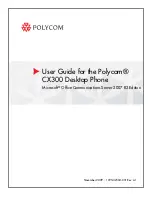
AEQ
PHOENIX STRATOS
42
-
RTP INACTIVITY MODE (only for IP interface): allows you to enable the detection of
audio signal absence in audio streaming over IP. This option will appear only when IP
interface is selected. When activated (and it is configured this way by default), the unit
will terminate the call when no RTP traffic is received after a certain time (specified in
the next option). This way you can avoid that the unit gets blocked when a call signaling
has been lost, for instance.
-
RTP INACTIVITY TIME (sec) (only for IP interface): configures the minimum waiting
time that the Phoenix STRATOS must wait before considering that the absence of audio
over RTP is final and irreversible and terminates the call (only when RTP INACTIVITY
MODE is ON). Values in seconds. The equipment is supplied with a default
configuration of 15 seconds. This option will appear only when IP interface is selected.
Exclusive configuration options for an IP interface
3.1.6.1. BACK UP submenu.
The BACK UP submenu offers the following options:
-
ENABLE: ON or OFF can be selected. Selecting OFF indicates that you do not wish to
use this redundancy option. Selecting ON gives meaning to the rest of the parameters
that are described below (the ON option is available only when a backup interface is
previously selected).
-
INTERFACE*: lets you select a free interface as a backup toward which to switch the
communication if there is a connection failure. When all the communication interfaces
are busy, the “NO INTERFACE FREE” message will be displayed.
-
CODEC / CODING (List): allows you to configure the encoding algorithm (or algorithm
list for IP interface configured in “PROXY SIP” or “DIRECT SIP” mode) to be used over
the selected backup interface. Obviously you can select a different algorithm in this
backup interface from the one selected in the main interface.
-
CALL TIME OUT: defines the minimum time interval for the connection to be
considered down and the communication interface switching to be performed.
-
RETRY ATTEMPTS: lets you select the number of retries to be made before
considering the communication down.
-
SYNC TIME OUT: defines the minimum time interval for the connection to be
considered down if synchronization is not performed, and the communication interface
switching to be performed.
-
CONTACT / URI (for IP interface configured in “PROXY SIP” or “DIRECT SIP” mode) /
DEST IP (for IP interface configured in “RTP Point to Point” mode): defines the
destination toward which the backup connection is to be launched. Depending on the
communication interface you have selected as a backup, this destination will be defined
by an ISDN subscriber number, a SIP identifier (URI) or an IP address. This option will
not appear when V35 interface is selected.
*NOTE: when you only want that the call using the main interface will be retried in case of a
connection failure, you just have to select a backup interface that you’re not using (V35, for
instance) and configure ENABLE as ON. This way, when communication is lost, the unit will
retry to connect (RETRY_ATTEMPTS times) and, when it’s not successful, will change to V35
interface. Since there is nothing connected to this interface, after the same number of retries, it
will change back to main interface and it will go on this way until the line is available again.
BACK UP function can be used together with AUTORECALL option (see next section) in order
to guarantee the link stability against different failure situations, such as line falls or power
supply failures.
















































